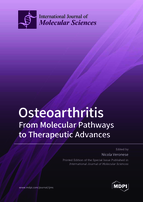Osteoarthritis: From Molecular Pathways to Therapeutic Advances
A special issue of International Journal of Molecular Sciences (ISSN 1422-0067). This special issue belongs to the section "Molecular Pathology, Diagnostics, and Therapeutics".
Deadline for manuscript submissions: closed (30 June 2021) | Viewed by 76704
Special Issue Editor
Interests: epidemiology; geriatrics; magnesium; frailty; osteoarthritis
Special Issues, Collections and Topics in MDPI journals
Special Issue Information
Dear Colleagues,
As you know, osteoarthritis (OA) is an epidemiologically relevant age-related disorder commonly affecting synovial joints and finally culminating in the irreversible destruction of the articular cartilage. OA is the most common musculoskeletal condition, particularly in advanced age, but its exact etiology is still not clear.
In this sense, inflammation seems to be a relevant pathway involved in the etiology of OA, but OA is mostly a degenerative and not an inflammatory condition. Moreover, it seems that the apoptosis of the cells of the articular cartilage could be important, but research in this direction is still limited to a few in vitro experiments. Finally, the molecular pathways involved in the therapeutic approaches used in OA are still poorly known.
Given this background, this Special Issue calls for original research papers, mini and full reviews, and perspectives that address the progress and current knowledge of the pathophysiological mechanisms of OA, particularly those regarding molecular explanations of the etiology of the OA. The Special Issue will also include therapeutic pharmacological and cell-based strategies, including stem-cell therapy, for improving OA outcomes.
Prof. Dr. Nicola Veronese
Guest Editor
Manuscript Submission Information
Manuscripts should be submitted online at www.mdpi.com by registering and logging in to this website. Once you are registered, click here to go to the submission form. Manuscripts can be submitted until the deadline. All submissions that pass pre-check are peer-reviewed. Accepted papers will be published continuously in the journal (as soon as accepted) and will be listed together on the special issue website. Research articles, review articles as well as short communications are invited. For planned papers, a title and short abstract (about 100 words) can be sent to the Editorial Office for announcement on this website.
Submitted manuscripts should not have been published previously, nor be under consideration for publication elsewhere (except conference proceedings papers). All manuscripts are thoroughly refereed through a single-blind peer-review process. A guide for authors and other relevant information for submission of manuscripts is available on the Instructions for Authors page. International Journal of Molecular Sciences is an international peer-reviewed open access semimonthly journal published by MDPI.
Please visit the Instructions for Authors page before submitting a manuscript. There is an Article Processing Charge (APC) for publication in this open access journal. For details about the APC please see here. Submitted papers should be well formatted and use good English. Authors may use MDPI's English editing service prior to publication or during author revisions.
Keywords
- osteoarthritis
- inflammation
- pathophysiology of osteoarthritis (OA)
- pharmacology
- biomarkers for osteoarthritis







